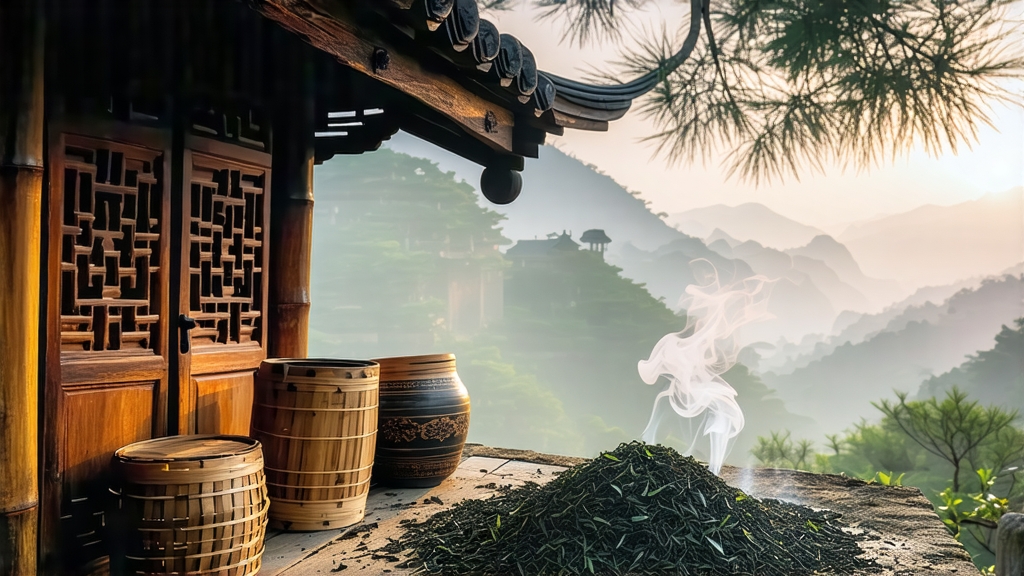
Ask most tea lovers to name a Chinese black tea and they will answer “Keemun” or “Yunnan Gold.” Few realize that the very first black tea ever created—long before those famous styles emerged—was Lapsang Souchong, a small-leaf cultivar from the Wuyi Mountains of northern Fujian. Revered in 17th-century London as “bohea,” later imitated from India to Ceylon, and still hand-crafted today above the misty Tongmu Gorge, Lapsang Souchong is both a living fossil and a bold, smoky pleasure that rewards anyone willing to look beyond the supermarket tea bag.
-
From Green to Black: A Happy Accident in the Ming Dynasty
Local legend says the shift from green to black occurred around 1568 when a passing army commandeered a tea village overnight. To dry the leaves quickly the next morning, farmers rushed them over fresh pinewood fires; the resulting amber liquor and resinous aroma proved irresistible to Dutch traders in Xiamen. Whether myth or marketing, the story captures the essential truth: oxidation plus pine smoke created a tea stable enough to survive the six-month sea voyage to Amsterdam and, soon after, to the coffeehouses of Restoration England. By the 1680s “souchong” (from xiao zhong, “small cultivar”) appeared in the ledgers of the East India Company at prices higher than silver. -
Terroir: Why Only Tongmu Can Birth the Original
The Wuyi range is a UNESCO World Heritage site where granite cliffs force humid maritime air upward, forming a near-permanent cloud blanket that slows photosynthesis and concentrates amino acids. Within this micro-climate the 48-square-kilometer Tongmu Nature Reserve remains the only place legally authorized to produce authentic Lapsang Souchong. Soils are acidic, rich in quartz and iron; daytime temperatures hover around 18 °C, dropping to 12 °C at night—ideal for the indigenous Caicha group of tea bushes whose leaves are noticeably smaller and more resinous than the Da Bai cultivars used for white teas nearby. -
Varieties: Smoked, Unsmoked, and the New Craft Expressions
Traditionalists divide Lapsang into three categories:
a) Zhengshan Xiaozhong—literally “original mountain small cultivar,” the protected-origin tea that must be withered over local Masson pine.
b) Wuyi Xiaozhong—leaves from surrounding villages processed the same way but lacking the Tongmu terroir; still excellent yet lighter in body.
c) Smoke-free Xiaozhong—developed for the modern Chinese palate, dried with hot air rather than pinewood, yielding a malty, longan-fruit sweetness that surprises drinkers expecting campfire aromas. -
Craft: One Leaf, Twelve Steps, and the Secret of Longan Charcoal
Harvest takes place from late April to early May, when two leaves and a bud are still pale green. After a gentle 6-hour outdoor wither, the leaves are moved onto bamboo trays above pinewood fires in a two-story shed. The lower hearth burns logs that have been aged for at least one year; green wood would blister the leaf. Smoke rises through slatted floors, perfuming the tea for 8–10 hours while artisans roll the leaves every 30 minutes to ensure even oxidation. Once 80 % dry, the tea is transferred to charcoal baskets fueled by longan-fruit stones that burn evenly at 60 °C, adding a subtle orchid note beneath the resin. The entire process spans 24 hours and demands constant human judgment—no timers, no thermostats. -
Chemistry in the Cup: Why Smoke Does Not Equal Harsh
Gas chromatography reveals that pinewood smoke imparts guaiacol and syringol, phenols that bond with the leaf’s own theaflavins during oxidation. The result is a smoother, almost sweet smokiness reminiscent of aged single-malt whisky, without the acrid bite cheaper teas acquire when liquid smoke is sprayed post-production. Meanwhile, the Wuyi mineral substrate translates into a flinty finish that Chinese tasters call yan yun—“rock rhyme.” -
Brewing: Gongfu vs. Western, Smoke vs. No Smoke
For the classic smoked style, use 4 g of leaf in a 120 ml gaiwan, 95 °C water, and start with a 5-second rinse to wake the leaf. Steep